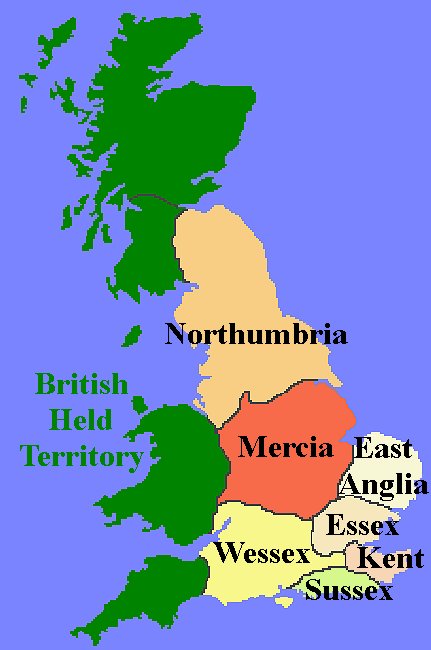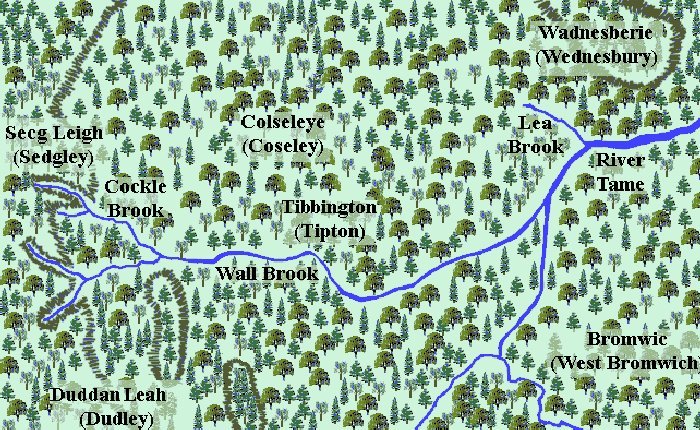|
Prehistoric times
The Black Country and most of South
Staffordshire was covered by dense woodland, interrupted
only by local rivers and streams. Travelling through the
area would have been extremely difficult and so it
remained largely unoccupied until Saxon times.
There is some evidence of
prehistoric rambling taking place. In 1928, half a
sandstone axe head from about 1,200 BC was found in the
Wolverhampton Grammar School playing field and a bronze palstave axe from 600 BC was found in a garden in
Finchfield. Similar tools have been found at Ashmore
(Wednesfield), Bushbury, Cannock and Wrottesley. A
polished flint axe head was found in Stafford Street,
Willenhall around 1920 and in 1963 a flint scraper from
around 6,000 BC was found on Goldthorn Hill,
Wolverhampton. Ancient flint tools were found at Bourne
Pool in Aldridge, and what is believed to have been a
Bronze Age barrow (Low Hill Barrow) once stood at
Bushbury.
Prehistoric man certainly had a
small presence in the area.
Roman Britain
There is no evidence of Roman
settlement in Dudley itself, but Romans were certainly
in the locality. Watling Street skirted the northern
edge of Walsall and Brownhills. It ran beside Wall, the
Roman fort on the southern edge of Lichfield. Wall,
originally called Letotceum, provided accommodation and
a change of horses for travellers, and had an inn and a
bath house. Another road ran from Wall to the fort at
Metchley and went through Sutton Coldfield. Part of it,
known as Icknield Street, can still be seen in Sutton
Park.
There were Roman forts at
Greensforge, about a mile and a half east of
Kingswinford. Two are situated by the Navigation Inn, on
either side of Mile Flat. They were semi-permanent
military dwelling places beside a small civilian
settlement. Nearby were four marching camps, used as
overnight stops for armies that were on the move. The
site held the largest local population up to that time
and was linked by a number of roads to other forts and
centres of population. The road to Droitwich, Worcester
and Gloucester lay to the south, the road to Watling
Street and Pennocrucium to the north and the road to
Bridgnorth, Wroxeter and Wales to the north west.
Traces of a Roman road have been
found at Bilston and Roman coins from the first century
were found at Wednesbury in 1817, including
examples from the reign of Nero, Vespasian, and Trajan.
Another Roman coin was found at Wood Green during the
excavation of the railway cutting, a piece of Roman
glass came to light in Monway Field, Wednesbury and a
Roman brooch was recently found at Aldridge. Other Roman
coins have been found in Bilston, Perry Barr, Great
Barr, Barr Beacon, and at Stonnall near Walsall Wood.
Anglo-Saxons
Angles and Saxons first reached our
shores during the Roman occupation and were mentioned by
the Roman historian Ammianus Marcellinus, who considered
them as barbarians along with the Picts and Scots. He
mentions raids in 365, and the mid-fifth century Gallic
Chronicle records a large raid in 410 after the Roman
army had departed.
| |
|
| Read about the
Anglo-Saxons |
 |
| |
|
Early colonisation started in the
6th century when Anglo-Saxons came from France, The
Netherlands, Germany and Denmark. There were frequent
raids by continental pirates and many towns employed
mercenary soldiers for protection. The soldiers were
Angles and Saxons from northern Germany who brought
their families with them and were given farmland as
payment for their services. Soon the mercenaries
realised that they were stronger than their employers
and so began to take over the running of many areas.
| The Anglo-Saxons slowly colonised
England, moving northwards and westwards,
pushing the native Celts into Cornwall,
Wales and Scotland. By 850 AD there were
three competing kingdoms; Mercia, Northumbria and Wessex.
South Staffordshire was a part of Mercia, which was derived from the old English word “Mierce”,
meaning People of the Boundaries.
The kingdom developed
from settlements in the upper Trent valley and was
colonised by a band of Angles called the Iclingas.
Slowly the area was populated and the kingdoms of the
Saxon and Angles in the midlands amalgamated to form the
kingdom of Mercia.
In 913 Stafford became the capital of Mercia after it had been fortified by Queen Aethelfaed. |
 |
Colonising the local area
In the 7th or 8th century a tribe
called the Anglian Mercens came from the north.
Initially they followed the Trent Valley, and began
spreading along the valleys of the Tame and its
tributaries. They were known as the Tomsaetan (dwellers
by the Tame), and would have been the first people to
settle here. There were several natural advantages for
them in this area, the ready-made clearings, an
excellent water supply from the local brooks, and the
elevated position, making the site easily defendable.
They may have arrived via Cockle Brook, which flows off
the Dudley and Sedgley hills into Wall Brook, and into
the River Tame.

The settlers would have occupied
clearings in the forest and cleared surrounding areas
for their cattle and crops. They built simple timber
framed, and possibly timber clad buildings. Timber being
in plentiful supply. The Old English word for a woodland
clearing is “leah” which appears in several local place
names including Dudley, a name derived from the Old
English 'Duddan Leah', meaning Dudda's clearing. Dudda
was probably the local chief. Other Black Country towns were
similarly named including Bentley, Brierley Hill,
Coseley, Cradley Heath, Sedgley and an area in Darlaston
known as The Leys.
Most of the local towns have names
that are Anglo-Saxon in origin. The old English word "tun"
meaning a settlement, is found in Bilston, Darlaston,
Essington, Tipton and Wolverhampton. Another old word
“halh” meaning a pocket of land appears in Willenhall,
Wednesbury means Woden's fort, Aldridge means 'Alder
village' and Rushall means a place in marshy ground,
where rushes grow.

An impression of an Anglo-Saxon
village.
In Saxon times there would have
been just a few simple single storey timber buildings
with a thatched, or turfed roof and a hearth for a fire,
with smoke escaping through the roof. All the furniture
such as beds, benches and tables would have been made of
wood. Valuable items and tools would have been stored in
a wooden chest.
All traces of the original
settlements have long disappeared due to the intense
human activity in the area throughout many centuries.
All evidence of the early settlements and their exact
location is gone.
After colonisation, Dudley would
have remained as a small farming community for several
hundred years. The local community would possibly have
cleared about one sixth of the land around their
settlement, where strip cultivation would have
adequately supported the small population. The names of
some of the early fields can be found in early
documents. Porters Field, also written as Potters Field
lay between the top of today's Hall Street and Castle
Hill alongside the land occupied by St. Edmund's Church.
It is possible that there was a pottery there. Another
field was Peaks Field, later called Peacocks Field that
was on the western side of today's Hall Street and to
the south of King Street. To the north of King Street
was Greystone Field that covered the area now occupied
by the Market Place and extended as far as today's
Wolverhampton Street. The modern main roads roughly
follow the old dirt tracks that ran between the fields.
Hall Street is named after an old
house (Ye Hall House) that was owned by the Throckmorton
family in the 16th century and stood at the top of Hall
Street.
The settlement would have been connected to surrounding
settlements by dirt tracks, such as the one across the
top of the ridge leading to Sedgley and Wolverhampton.
There must also have been a track leading to Tipton and
Wednesbury, so the small communities were far from
isolated. Cattle, crops and domestic items could be
traded and purchased. Some of the locals would have
specialised in woodwork or metalwork, or possibly made
clothes. So even at this early date there could have
been some tiny industries in operation, supplying the
local village and trading with nearby communities.
|